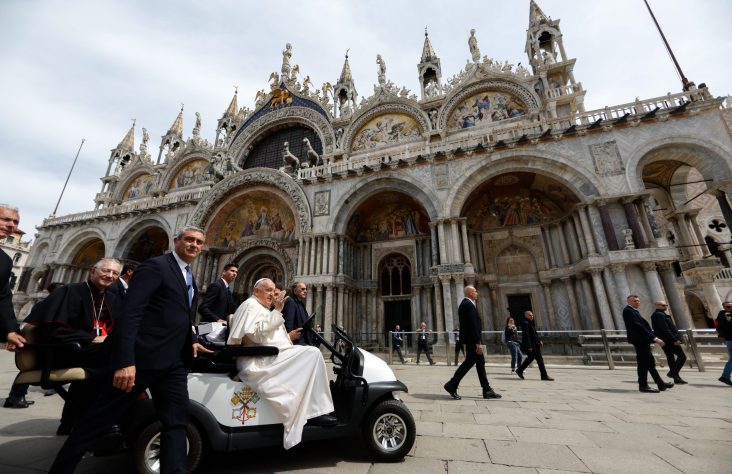April 2, 2013 // Uncategorized
The joyful mysteries of married life
I was driving my daughters to ballet class last Monday. At a red light we spotted an older couple coming out of a diner. The man and woman were elderly, appearing to be in their 80s. He was dressed in khakis and a dark jacket. She was wearing a feminine coat and what my grandmother would have called sensible slacks. They were holding hands.
As we waited for the light to turn green, my girls and I watched the couple slowly hobble down the sidewalk. The gentleman was livelier in his step and every few moments he would pause, arm extended, and patiently wait for his companion (presumably his wife), who seemed to have trouble with one leg. It was sweet to see this juxtaposition of slow steadiness and dedication against the busy highway, full of cars whizzing by, and young people on the sidewalk, zipping past the older couple.
I smiled.
As I watched this pair momentarily, I couldn’t help but think about the joyful mysteries of married life — what makes a marriage last, how couples survive the tumultuous waves and assaults against them in modern society, how married love helps individuals become their best selves, with opportunities to grow in unselfishness, devotion and an increase in faith over the years.
The joyful mysteries of married life, I pondered, even seem to correspond with the joyful mysteries of the rosary. Many of the lessons are the same:
The first joyful mystery is the Annunciation. The Angel Gabriel comes to Mary and asks her to be the Mother of God. Mary’s “fiat,” her “yes” to God in faith, not knowing the specific details of the plan, is a great example to married couples. Through her “yes,” Mary cooperated with God to bring Jesus into the world. Married couples can learn a lot from Mary in this first joyful mystery.
In faith, on their wedding day, a couple takes a solemn vow to honor, love and be faithful until death. The purposes of their marital union are unitive (joining them in friendship and pulling them toward heaven) and pro-creative (open to life, begetting and educating children). In faith, the man and woman promise to be true to their vows, not knowing the specifics of what the future holds. Their initial “yes” to one another, and daily “yeses” thereafter bring about their fulfillment and the fulfillment of a family. A married couple’s stability is the fertile soil for the healthy development of their children. Their love ensures their children’s security, and in demonstrating love for one another they model Christ’s own love for His Church, and the Church’s reception of that love. Like Mary, the couple says “yes” in faith, and trusts God to do His work in them.
The second joyful mystery is the Visitation. Mary goes to visit her cousin Elizabeth, who is pregnant with John the Baptist. Mary is not self-absorbed with her own pregnancy, but chooses to serve rather than be served. She demonstrates hospitality even in her own need.
Married couples can learn from Mary that their relationship must be one of service toward each other. Service can be demonstrated in big ways, such as in heroic sacrifices, but in small ways as well, such as a husband making coffee for his wife in the morning or a wife rubbing her husband’s feet after a long day at work. A couple follows the joyful mystery by putting his or her spouse’s needs above his or her own, steadily, day after day, looking first to see what can be done to serve the other.
The third joyful mystery is the birth of Christ. From the birth of Christ is demonstrated the manifestation of God’s love for mankind. God sent His Son to earth for man’s salvation. A human baby is not divine, of course, but he is a gift nonetheless, to the married couple, to society at large, and to the child himself.
Through the mutual self-giving of man and woman in married love, God creates a new human being. God could have individually created each new human person without the collaboration of man and woman, but He chose to involve earthly parents in the process.
Married couples can learn from the third mystery of the awesome nature of their vocation, the deep love God has for them and for families, and of the respect and reverence due to one another. Married couples also learn the preciousness of each and every child. As Jesus was born in a humble stable and God provided to the Holy Family all its needs, married couples can learn to trust God for what they need and depend upon His generous provision, even in seemingly impossible times.
The fourth joyful mystery is the Presentation. This is when Joseph and Mary take baby Jesus to the Temple, as prescribed by Jewish law. This mystery demonstrates the Holy Family’s humble obedience to God, even in their privileged position. Married couples can learn from this mystery the importance of following God’s commands in their married and family life.
The fifth joyful mystery is the Finding in the Temple. Married couples can learn that misunderstanding is a part of life and trust and faith are the answers. In a broader sense they can understand how important it is to “search” for Jesus in their own families.
A moment at a stoplight on Monday, offered me a chance to ponder the mysteries of married life, and how they are not unlike the joyful mysteries of the rosary. A married couple that follows the examples of the rosary’s joyful mysteries in their daily lives can find depth and meaning, and a growth in faith, resulting in deeper joy in their marriage.
The best news. Delivered to your inbox.
Subscribe to our mailing list today.





